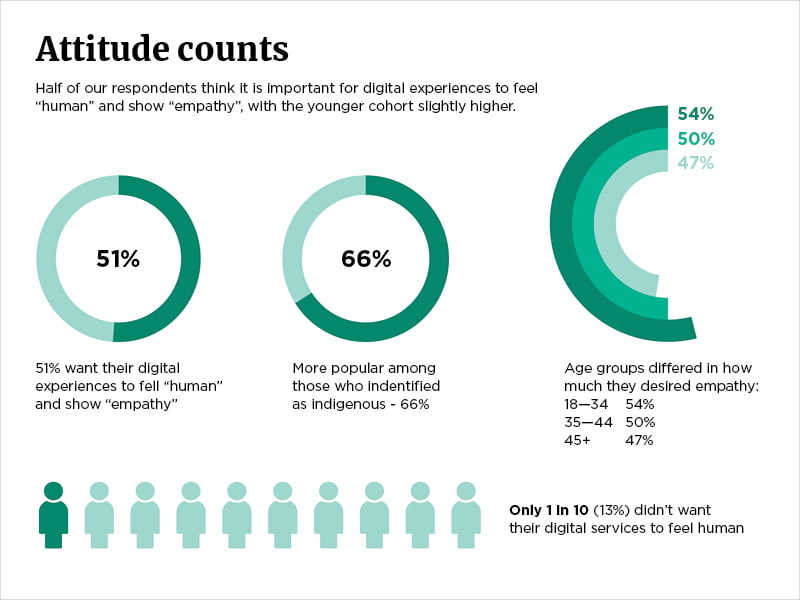State governments have recognised the importance of bolstering digital strategies in their recent budget announcements, with millions of dollars invested into various initiatives for the coming year.
During budget speeches, the NSW government announced further investment in a Single Digital Patient Record system and WA set forth plans to implement single digital identities, showing that both governments are committed to addressing citizen needs head on.
The Victorian budget also noted significant investment towards their proposed single digital presence platform earlier this year.
These plans are a clear response to people’s increased expectations for more accessible, responsive, transparent and secure digital government services. And the onset of the global health and economic crisis has reinvigorated the role of digital services in everyday life.

People from all backgrounds and abilities are moving to online services, whether by necessity or choice. In fact, 80 per cent of the 1,500 Australian residents we recently surveyed used digital government services last year.
These same respondents, however, are calling for digital improvements – such as pre-filled form technology and greater availability of medical data to healthcare professionals.
A keen appetite for a single digital identity similarly shone through to streamline and simplify how we all engage with these services, as did a desire for more controls over how personal information is shared across government agencies.
The digital investment announced by state governments so far this year is a welcome step towards transforming government services. But to achieve this goal, there are some key considerations to consider for a successful strategy implementation.

Reinvigorate foundations
Starting from scratch isn’t always possible, or necessary. With the right approach, many existing systems can be reimagined and transformed for an online future, rather than replaced.
Assessing whether systems can be digitised to agile and scalable cloud platforms, which can result in real time insights and policy updates, is an important first step.
Policy agility is key
Policy evolution directly impacts people’s livelihoods, so implementing legislated changes through technology can understandably become complex and time-consuming.
Taking an agile, modular approach to policy change can accelerate implementation and better assess the impact of each change. It also can drive greater collaboration and sharing between departments, agencies and partners.
Unbiased data forges trust
Unbiased, non-sensitive citizen data is a strategic asset which governments can use to make evidence-based decisions that in turn improve people’s livelihoods. When this data is securely shared across government platforms, it can optimise citizen experience, help governments form a single view of a person and their needs, improve efficiencies and reduce expenditure.
But a privacy-first approach to citizen data is key – in fact over a third of respondents in our research cited privacy, trust, and security as critical to their use of these online services.
In relation to sharing personal information, over fifty per cent of the respondents said they are comfortable doing so, but only if they know how it will be used and stored, emphasising the need for better disclosure.
Humanise digital services
Putting citizens at the core of every digital service – right from the design stage – is crucial. Stepping into citizens’ shoes to view their needs and challenges is so important.
This may include deep research, prioritising citizen feedback and integrating HX (Human Experience) design in evolving services.
Half of the people we surveyed want digital experiences to feel ‘human’ and show ‘empathy’. Combining Customer Experience, User Experience and Employee Experience techniques – with a layer of creative thinking – can achieve better overall HX.
Leave no one behind
Considering diverse abilities and needs of communities is essential to optimising the future of digital government services.
We know that digital disadvantage coincides with other forms of social and economic barriers, meaning those who need support the most often face the greatest risk of being left behind on the digital journey.
In fact, close to 90 per cent of people we surveyed believe governments need to better service those with a disability.
By integrating inclusivity into platform design, such as considering whether technology is compatible with assistive technology, or if content is accessible in other languages, means governments can avoid building new barriers for people of various abilities and backgrounds.
Optimise the innovation ecosystem
An evolution as widespread as a digital government can’t happen in silo. Continuing to foster collaboration between the public sector, private entities, not-for-profit organisations, and the academic world rewards governments and their constituents with fresher ideas, more robust approaches, and strategies.
When approached properly, enhancing digital services can provide governments with more access to unbiased data, enable greater agility to rapidly adopt policy changes and make government interaction seamless.
That is ultimately what citizens want – an engaging, open and reliable way to use digital government services, wherever and whenever they need.
Allen Koehn is Vice-President and General Manager of Public Sector at Infosys.
This article was prepared by Infosys in partnership with InnovationAus.com.
Do you know more? Contact James Riley via Email.

It’s claimed endlessly (boringly) that “citizens have greater expectation of government digital services”. If you say something often enough maybe it becomes a fact, but that hasn’t happened yet. I have never seen any survey or statistics to support this boringly repeated claim (Allen provided none here. That link goes to company advertising. Allen?). What I’ve seen is endless (boring) graphics of some sort of facial recognition. I guess the plan is to normalise facial recognition in people’s minds, so that they submit without turning their brains to ON mode. If they happened to be ON they would run away as fast as they could. The image should be of the facial surveillance used in China (https://cms.qz.com/wp-content/uploads/2020/02/1581746326404096.png). When the Chinese government uses facial recognition it’s BAD. When nobody here is asking for it, but people keep repeating themselves, it’s labelled as GOOD. But it’s never good, and no matter how many times you echo, it’s never requested. ps. As soon as you read “agile and scalable cloud platforms” you can be sure the words come straight out of large IT company’s marketing book. If you ever read “optimise citizen experience with policy agility” you know you’ve left orbit and are headed to another galaxy under koolaid power.